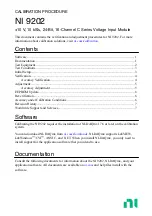
© National Instruments Corporation
ix
DAQCard-500 User Manual
About This Manual
This manual describes the mechanical and electrical aspects of the DAQCard-500 and contains
information concerning its installation and operation. The DAQCard-500 is a compact, low-cost,
low-power analog input, digital I/O, and timing I/O board for computers that are equipped with a
Type II PCMCIA socket.
Organization of This Manual
The DAQCard-500 User Manual is organized as follows:
•
Chapter 1, Introduction, describes the DAQCard-500, lists what you need to get started, your
software programming choices, and explains how to unpack the DAQCard-500.
•
Chapter 2, Installation and Configuration, describes how to install and software configure the
DAQCard-500.
•
Chapter 3, Signal Connections, describes the signals on the PR27-30F I/O connector and the
CB-27 connector block, optional accessories available from National Instruments.
•
Chapter 4, Theory of Operation, includes an overview of the DAQCard-500 and explains the
operation of each functional unit making up the DAQCard-500.
•
Appendix A, Specifications, lists the specifications of the DAQCard-500.
•
Appendix B, Differences between the DAQCard-700 and the DAQCard-500, contains a
summary of differences between the DAQCard-700 and the DAQCard-500 that may be
relevant to you if you are a current DAQCard-700 user.
•
Appendix C, Custom Cable Design, describes the pin connections on the DAQCard-500,
which you will need to use only if you are designing your own cable.
•
Appendix D, PC Card Questions and Answers, contains a list of common questions and
answers relating to PC Card (PCMCIA) operation.
•
Appendix E, Power-Management Modes, describes the power-management modes of the
DAQCard-500.
•
Appendix F, PSH27-50F Signal Connections, gives the pin assignments for the CB-50 I/O
connector block when using the PSH27-50F-D1 cable with the DAQCard-500.
•
Appendix G, Customer Communication, contains forms you can use to request help from
National Instruments or to comment on our products.
•
The Glossary contains an alphabetical list and description of terms used in this manual,
including acronyms, abbreviations, metric prefixes, mnemonics, and symbols.
•
The Index alphabetically lists topics covered in this manual, including the page number
where you can find the topic.
Conventions Used in This Manual
The following conventions are used in this manual:









































